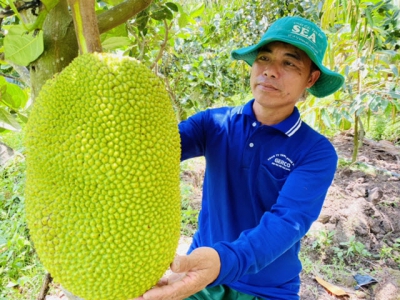Modest processing rate - Vietnamese fruits disadvantage

Enterprises are called for investing further in food processing which is expected to help Vietnamese fruits have more advantages in accessing markets including demanding ones.
Thai jack fruit is grown in Mekong Delta region. Photo: Le Hoang Vu.
Agriculture officials in localities across Vietnam emphasized the importance of processing in increasing the value-added to Vietnamese fruits.
Doan Van Danh, director of Ben Tre Province’s Agriculture and Rural Development Department said that years ago, the province was highly reliant on the export of raw coconut to China, which made the struggle whenever China refused to import coconut and local farmers were forced to sell coconut at low prices.
Now, Vietnam’s exports of agriculture products depended less on China’s import, he said, adding that a fundamental solution was to encourage enterprises to invest more in food processing.
For examples, Luong Quoi Company used to purchase 500,000 coconuts daily and have yearly revenue of about VND400 billion. Now, it pursued the same quantity but with deep processed coconut products, they could gain a yearly revenue of VND 1 trillion, Danh said.
“Thanks to further processing, farmers could sell coconuts at better prices, more jobs are created, enterprises also gain better profits,” he said.
It was necessary to call on and create favourable conditions for major enterprises to invest in food processing as raw fresh farming products had a low value and the exports of such products were badly reliant on importers who, in cases, imposed low prices to buy the products, he said.
Danh also emphasised the role of co-operatives as their involvement in value chains helped make high-quality products.
Instead of working with hundreds of farming households, enterprises could co-operate with co-operatives to form concentrated production areas. Co-operatives also helped to ensure systematic consistent farming technique to be used in large areas.
Pham Minh Truyen, director of Tra Vinh Province’s Agriculture and Rural Development Department said that it was also necessary to increase regional linkage.
Currently, Vietnam still lacked enterprises that are big enough to invest in processing and seek more markets, Truyen said.
Tran Thai Nghiem, vice director of Can Tho Province’s Agriculture and Rural Development Department said that the province had over 21,000 ha of fruits and almost all typical fruits of the southern region were grown in the province.
However, Vietnam faced difficulties in exporting fruits because of its modest ability in post-harvest storage and processing.
With a developed processing industry, some countries could have their fruits fresh for 5-6 months after harvesting.
“Five Central Highlands provinces have a total of about 9,060 ha of passion fruit, of them, Gia Lai Province has more than 3,000 ha with the production of 84,000 tonnes. Gia Lai is known to have the highest processing rate of 18 per cent while the percentage in other provinces is less than 2 per cent. Gia Lai Province has such a high processing rate thanks to the fruit processing factory Doveco of Dong Giao Company which cooperates with co-operatives. Each of the co-operative on average earns VND 43-68 billion yearly from providing passion fruit for the factory,” Tran Minh Hai, Director of the Center for Training and Consulting on Cooperative Economy under School of Agriculture and Rural Development Managers II.
The southern province of Vinh Long had 14,000 ha of sweet potato, producing about 350,000 tonnes per year but only 3,000 tonnes accounting for 0.9 per cent of the production - was processed, Hai said.
Related news
Tools

Phối trộn thức ăn chăn nuôi

Pha dung dịch thủy canh

Định mức cho tôm ăn

Phối trộn phân bón NPK

Xác định tỷ lệ tôm sống

Chuyển đổi đơn vị phân bón

Xác định công suất sục khí

Chuyển đổi đơn vị tôm

Tính diện tích nhà kính

Tính thể tích ao



 Businesses 'join hands' to consume lychees, farm produce
Businesses 'join hands' to consume lychees, farm produce  Firm wins big from model of organic rice,…
Firm wins big from model of organic rice,…